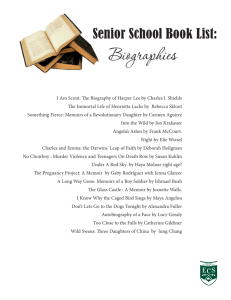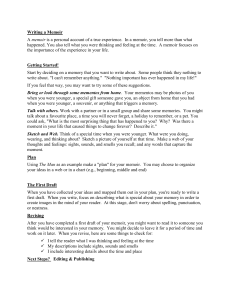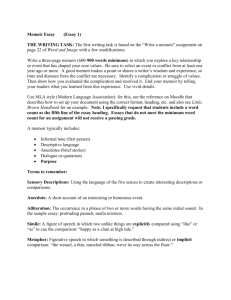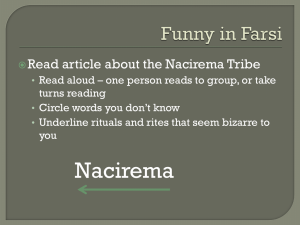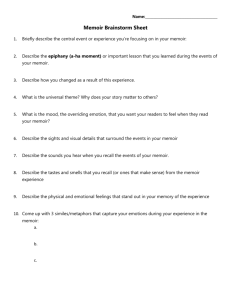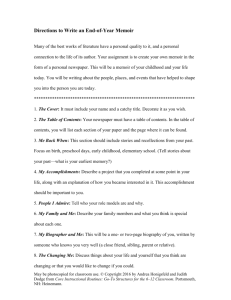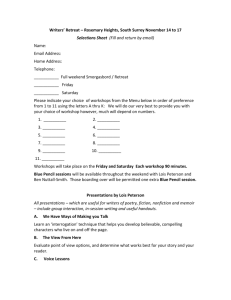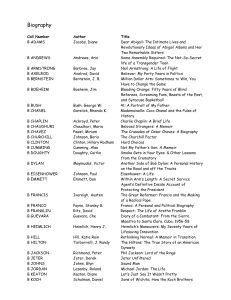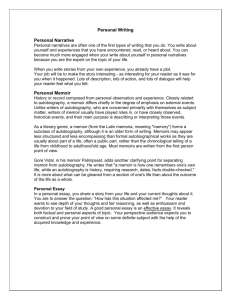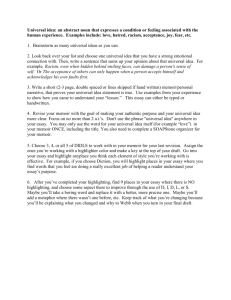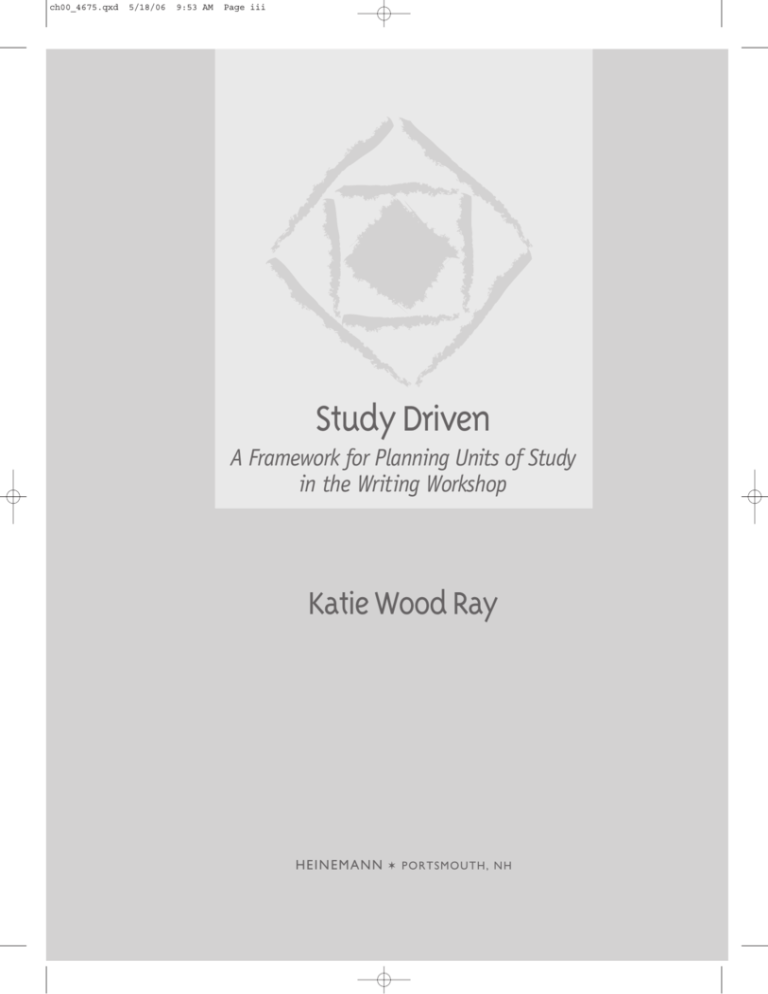
ch00_4675.qxd
5/18/06
9:53 AM
Page iii
Study Driven
A Framework for Planning Units of Study
in the Writing Workshop
Katie Wood Ray
HEINEMANN ✶ PORTSMOUTH, NH
ch00_4675.qxd
5/18/06
9:53 AM
Page iv
Heinemann
A division of Reed Elsevier Inc.
361 Hanover Street
Portsmouth, NH 03801–3912
www.heinemann.com
Offices and agents throughout the world
© 2006 by Katie Wood Ray
All rights reserved. No part of this book may be reproduced in any form or by any
electronic or mechanical means, including information storage and retrieval systems,
without permission in writing from the publisher, except by a reviewer, who may
quote brief passages in a review, with the following exception: Figure 6–2 may be
photocopied for classroom use only.
The author and publisher wish to thank those who have generously given permission
to reprint borrowed material:
“Real Trees: Where they come from. And where they came from.” by Timothy Harper
was originally published in Delta Airlines’ Sky magazine (December 2004). Reprinted by
permission of the author.
“Cheetah Chase” by Susan Yoder Ackerman. From CLICK magazine (July/August 2005,
Vol. 8, No. 6), text copyright © 2005 by Susan Yoder Ackerman. Reprinted by permission of Carus Publishing Company.
“Backyard Camp Out” by Gerry Bishop. From the September 2004 issue of Ranger
Rick® magazine. Copyright 2004 by the National Wildlife Federation®. Reprinted with
the permission of the publisher, the National Wildlife Federation®.
(Credits continue on p. 290.)
Library of Congress Cataloging-in-Publication Data
Ray, Katie Wood, 1964–
Study driven : a framework for planning units of study in the writing workshop /
Katie Wood Ray.
p. cm.
Includes bibliographical references and index.
ISBN 0-325-00750-0 (alk. paper)
1. Creative writing (Elementary education). 2. English language—Composition and
exercises—Study and teaching (Elementary). I. Title.
LB1576.R374 2006
372.62′3—dc22
Editor: Lois Bridges
Production: Elizabeth Valway
Cover design: Catherine Hawkes, Cat and Mouse
Interior design: Jenny Jensen Greenleaf
Composition: Publishers’ Design and Production Services, Inc.
Manufacturing: Steve Bernier
Printed in the United States of America on acid-free paper
10 09 08 07 06 ML 1 2 3 4 5
2006003258
ch00_4675.qxd
5/18/06
9:53 AM
Page vii
Contents
Acknowledgments . . . . . . . . . . . . . . . . . . . . . . . . . . . . . . . . . . . . . . . . . . . . . . . ix
Introduction. . . . . . . . . . . . . . . . . . . . . . . . . . . . . . . . . . . . . . . . . . . . . . . . . . . . xi
SECTION ONE
Grounded Understandings
1
1
Two Snapshots of Studies in Action . . . . . . . . . . . . . . . . . . . . . . . . . . . . . .3
2
Making a Case for Study . . . . . . . . . . . . . . . . . . . . . . . . . . . . . . . . . . . . .22
3
Before Revision, Vision: What Have You Read That Is Like What
You’re Trying to Write? . . . . . . . . . . . . . . . . . . . . . . . . . . . . . . . . . . . . . .35
4
Understanding the Difference Between Mode and Genre . . . . . . . . . . . .53
5
The World Is Full of Writing: Finding Texts for Teaching . . . . . . . . . . .64
6
Deciding What to Study from a World of Possibilities . . . . . . . . . . . . . . .78
7
Selecting Texts to Anchor Close Study . . . . . . . . . . . . . . . . . . . . . . . . . . .95
SECTION TWO
Informed Practice
107
8
Setting the Stage . . . . . . . . . . . . . . . . . . . . . . . . . . . . . . . . . . . . . . . . . . .109
9
Reading Immersion and Close Study . . . . . . . . . . . . . . . . . . . . . . . . . . .124
10
Turning Talk into Text: The Language of Specific Curriculum . . . . . . .140
11
Writing Under the Influence in All Phases of Study . . . . . . . . . . . . . . .151
12
The Predictable Rhythm of Process Studies in Writing Workshop . . . .164
13
The Tension of Time, the Promise of Depth . . . . . . . . . . . . . . . . . . . . .179
■ vii
ch00_4675.qxd
5/18/06
9:53 AM
Page viii
SECTION THREE
Resource Sections
187
Introduction . . . . . . . . . . . . . . . . . . . . . . . . . . . . . . . . . . . . . . . . . . . . . . . . . .189
Study Possibilities
Memoir . . . . . . . . . . . . . . . . . . . . . . . . . . . . . . . . . . . . .192
Short Stories of Realistic Fiction . . . . . . . . . . . . . . . . . . .196
Historical Fiction . . . . . . . . . . . . . . . . . . . . . . . . . . . . .199
True Stories from History: Historical Narrative . . . . . . . .201
Crafting Family Stories into Literature . . . . . . . . . . . . . .203
Poetry . . . . . . . . . . . . . . . . . . . . . . . . . . . . . . . . . . .205
Journeys of Thought: The Essay . . . . . . . . . . . . . . . . . . . .209
Features Articles and Literary Nonfiction . . . . . . . . . . . . .215
Practical How-to Writing . . . . . . . . . . . . . . . . . . . . . . . . .220
Informative How-to Writing . . . . . . . . . . . . . . . . . . . . . . .222
Advice Writing . . . . . . . . . . . . . . . . . . . . . . . . . . . . . . . . .224
Feature Articles Based on Interviews . . . . . . . . . . . . . . . .227
Exploring Possibilities: List Articles . . . . . . . . . . . . . . . . . .230
Biographical Sketches and Profiles . . . . . . . . . . . . . . . . . .232
Editorials, Commentary, and All Things Op-ed . . . . . . . .235
ABC Texts . . . . . . . . . . . . . . . . . . . . . . . . . . . . . . . . . . . .238
Reviews . . . . . . . . . . . . . . . . . . . . . . . . . . . . . . . . . . . . . .239
News Reporting . . . . . . . . . . . . . . . . . . . . . . . . . . . . . . . .243
Photo Essay . . . . . . . . . . . . . . . . . . . . . . . . . . . . . . . . . . .245
Slice-of-Life Writing . . . . . . . . . . . . . . . . . . . . . . . . . . . . .247
Topical Writing . . . . . . . . . . . . . . . . . . . . . . . . . . . . . . . .251
Survey of Different Kinds of Writing in the World . . . . . .253
Multigenre Writing . . . . . . . . . . . . . . . . . . . . . . . . . . . . .254
How Writers Use Punctuation as a Crafting Tool . . . . . . .255
How Illustrations and Graphics Enhance Meaning . . . . . .257
How Writers Make Paragraphing Decisions . . . . . . . . . . .258
How Writers Craft Texts in Interesting Ways . . . . . . . . . .260
How to Craft Using Obvious Text Structures . . . . . . . . . .262
The Work of Author’s Notes in Texts . . . . . . . . . . . . . . . .265
How Writers Decide on Titles . . . . . . . . . . . . . . . . . . . . .267
Appendix A. . . . . . . . . . . . . . . . . . . . . . . . . . . . . . . . . . . . . . . . . . . . . . . . . . . 269
Works Cited . . . . . . . . . . . . . . . . . . . . . . . . . . . . . . . . . . . . . . . . . . . . . . . . . . 271
Index. . . . . . . . . . . . . . . . . . . . . . . . . . . . . . . . . . . . . . . . . . . . . . . . . . . . . . . . 279
viii ■
Contents
ch00_4675.qxd
5/18/06
9:53 AM
Page xi
Introduction
O
ne of my favorite poets was doing a book signing at a recent conference I attended. As I approached her table, no one else was there so
I decided to take the opportunity to tell her how much I loved her
work. I explained that she was one of the few poets whose books I would order
sight unseen. I told her that her anthologies of poems usually anchored any
genre study of poetry I taught because I wanted children to see how she took a
single topic and wrote a whole collection of poems about it. I told her how
much the students I work with and I had learned from her about how to write
poetry, particularly how to trust in the beauty and simplicity of images and words.
I said that we loved her author’s notes because they helped us understand how
she found poetry in the world around her. I thanked her for all the many ways
her poetry had enriched my teaching for years and said I couldn’t wait for more
and more wonderful books from her.
When I finally finished my somewhat effusive outburst, she asked me if I
knew they had newly developed curriculum guides and lesson plans to go with
many of the anthologies I’d just spoken of with such affection.
My heart sank just a little.
I tried not to show it and I said something like, “Oh, how wonderful.” I didn’t
want to hurt her feelings and I knew she meant well, but curriculum guides and
lesson plans were not what I wanted or needed. I mean, I’d just described in
fairly specific detail how her books had been beside me, enriching my teaching
for years! You see, what she didn’t understand was that the teachers I work with,
their students, and I anchor our studies of how to write poetry well in her anthologies of poems. If we had lessons, we wouldn’t need study, and it’s study
that drives us.
We love study, and we love it for so many reasons. First, we love it in its full
verb sense because it requires us—teachers and students—to be active in the
pursuit of curriculum. Lock us in room full of this poet’s books and let us have
at them. Come back in a few days and we’ll tell you more than you want to know
about how to write poetry well, and, more importantly, we’ll be writing some
pretty good poetry of our own by then. We love to study things, and we know
■ xi
ch00_4675.qxd
5/18/06
9:53 AM
Page xii
how to study things, and we love that there is nothing to the teaching unless
we’re there making it happen.
In contrast, lessons—even heady, interesting lessons—are already written
and ask us to be sort of passive and just listen or do what they say. They would
ask the same thing of the class next door, or the class across town. And though
they may go by the name “study,” we realize no one’s really studying anything if
the lessons are already written. We love engaging in work that asks more of us,
as study does.
We love study because it allows us to ask very big questions about writing,
questions that never feel finished, such as, “How do people write poetry really,
really well? Where do they get their ideas? What’s their process like, from ideas
to finished poems?” Studies begin with questions like these, and then study itself,
in the verb sense, leads us to answers. Lessons, on the other hand, begin with the
answers already written. And sometimes, because they were written so far away
from us, we’re not even sure what the questions were to begin with.
We love study because it expands curricular possibilities. Who knows what
we might learn in five days, locked in a room full of wonderful poetry? Lessons,
necessarily, reduce curricular possibilities because someone must predetermine
what they will be. That would be okay if we weren’t dealing with such big questions in our studies. But to reduce a question like, “How does someone write poetry really, really well?” to a few manageable answers belies the complexity of
the question itself, and we embrace its complexity.
Related to this, we love study because we are energized by the idea that we
don’t know exactly what we’ll be talking about on, say, Thursday, but we know
it will be good, because this poet’s books are so good. We like knowing we have
to contribute, we have to help build, the content that will lead us to Thursday.
We find school much more interesting that way, when we play such an important role in shaping what happens there, and the expansionist stance of study
makes it feel like anything is possible. When someone else has already done all
that building and shaping for us, it’s a little bit harder to get excited about it all.
We love study, and this book is about study as a driving force in the teaching of writing. I’m so excited to have finally written about it in such a way that
I hope other teachers and students can get excited about it, too. I hope this book
will give you both the confidence to engage in authentic study with your students (if you’re not already doing that; I know lots of you are), and the practical know-how to fill your studies with rigor and challenge.
I’ve organized Study Driven: A Framework for Planning Units of Study in the
Writing Workshop into three sections that move from grounded understandings
to informed practice to supportive resources. I settled on this organization because it represents one of my most fundamental beliefs about teaching: that best
practice is always informed practice. But I also believe we’re at a critical juncture
xii ■
Introduction
ch00_4675.qxd
5/18/06
9:53 AM
Page xiii
in our profession that calls on us to be even more than informed, it calls on us
to be grounded in what we believe about teaching and learning.
As you look at the contents, you’ll see that Chapters 1 through 7 are the
“grounding chapters” and my hope is that they will build theoretical, foundational understandings about study as an instructional framework for the teaching of writing. Chapters 8 through 12 are the “informed practice” chapters and
they explore each phase of an instructional framework for study in detail. In
them, you’ll find a suggested menu of possibilities for classroom work inside each
phase. In Chapter 13, “The Tension of Time, the Promise of Depth,” I’ve attempted to pull everything together and think about study as a realistic option in
the time-pressed world of school where teachers and students live out their days.
In between each of these thirteen chapters, I have inserted twelve Craft Pauses,
little time-outs to marvel at the wondrous words of writers. I’ve pulled the pauses
from all walks of my reading life: children’s literature, adult literature, poetry, journalism. The purpose of these pauses is twofold. First, they are celebratory. I love
to celebrate wondrous words and take every opportunity I can to share them. I
hope you enjoy them just for the sheer delight of writers writing well.
Second, the Craft Pauses are meant to demonstrate the kinds of things you
and your students will learn about writing when you study it together. All of
them I’ve pulled from my own years of looking closely at what writers are doing
when they write well. I know that it may be hard to imagine what might come
of study if you’ve never engaged in it, so in addition to what you will see in the
regular chapters, I want the Craft Pauses to add another layer of demonstration
of what’s possible.
Finally, Section Three is the resource section and it begins with its own introduction that will help you understand how to use the resources. Following
the introduction, I’ve included ideas for more than thirty different studies you
might undertake in your writing workshop. Thirty ideas for studies are a lot of
ideas, but actually my suggestions are in no way exhaustive. My hope is that as
you read through them, some of them will appeal to you and you’ll think, “I’d
like to study this with my students,” and others will give you ideas for studies
you’d like to try that I haven’t suggested as possibilities. After all, the beauty of
knowing how to engage in study with your students is that you can study anything in basically the same way.
Introduction ■ xiii
ch14_4675.qxd
5/18/06
10:18 AM
Page 187
section
THREE
Resource
Sections
ch14_4675.qxd
5/18/06
10:18 AM
Page 192
S TUDY P OSSIBILITY
Memoir
M
emoir is a type of autobiographical nonfiction where a writer takes
a reflective stance in looking back on a particular time in his or her
life. The time may be connected to a particular event that happened
during that time, or to a person, a place, or an object from that time that is particularly vivid. Memoir is most often written in first person, in the past tense,
and generally has some quality of reflection attached to it. In other words, readers don’t just get the memory, they also get a sense of the person who is remembering. Sometimes personal essays fulfill the intentions of memoir.
There is some gray area in the distinction between autobiography and memoir. Generally, something referred to as a memoir is more focused and doesn’t try
to faithfully recount the chronology of a life in the way an autobiography does.
Also generally, autobiography is more the domain of those whose lives have
been made famous in some way and people want to know about the life because
of that fame. Famous people might also write more focused memoir, but very
few nonfamous people write the whole stories of their lives (autobiography) and
have them published. Nonfamous people write memoir all the time, however,
and people like to read it just because they like to hear the stories of other people’s lives.
newspapers
Sometimes newspapers will have special feature sections that have memoir in
them. My local paper, the Asheville Citizen-Times, has a weekly column called
“Our Stories.” Readers submit pieces for publication in this column, and they
are usually memoir. Sometimes around the holidays, newspapers will have story
contests and these submissions are often memoir, too. And from time to time,
columnists in the “Life” or “Family” sections of papers will write memoir. You
have to be on the lookout for these—the column won’t have a different label or
title on it to alert you that it’s memoir.
192 ■
ch14_4675.qxd
5/18/06
10:18 AM
Page 193
magazines
I get some of my best examples of memoir from magazines, most often women’s
magazines. For some reason, the memoir is often found on the back page
columns, as it is in my beloved monthly Southern Living. The “Lives” column in
the New York Times Magazine is often memoir as well. One of my favorites from
there is a column written by Nicole Keeter in the May 5, 2005 issue. Ketter
writes about her experiences as the only black child living in a small Iowa town
in the early 80s, and how everything changed when another black child arrived
at the school. It’s beautifully written, and it has a prized place in the memoir section of my fat blue notebook.
picture books
Memoir is found in picture books. Before I place a book in this stack, I like to
find some communication from the writer (in either an author’s note or dedication) that the book is a work of memoir. Sometimes I can make this judgment
on my own if I know a lot about the writer’s life. Here’s a short starter stack to
get you started searching.
Calling the Doves/El canto de las palomas
Christmas in the Country
Saturdays and Teacakes
The Trip Back Home
Two Mrs. Gibsons
Juan Felipe Herrera
Cynthia Rylant
Lester Laminack
Janet S. Wong
Toyomi Igus
collections
There are actually several different kinds of collected memoir, so I’ll make those
distinctions in these starter stacks.
Collections of Memoir Vignettes by Different Authors
I Thought My Father Was God and Other
Paul Austere, editor
True Tales from NPR’s National
Story Telling Project
Linda Brown, You Are Not Alone:
Joyce Carol Thomas, editor
The Brown v. Board of Education
Decision
The Milestones Project: Celebrating
Richard and Michele Steckel,
Childhood Around the World
editors
Study Possibility: Memoir ■ 193
ch14_4675.qxd
5/18/06
10:18 AM
Page 194
Guys Write for Guys Read
(Most selections are memoir)
Jon Scieszka, editor
Collections of Memoir Vignettes by Single Authors
The Circuit: Stories from the Life of a
Francisco Jiménez
Migrant Child
Marshfield Dreams
Ralph Fletcher
My Father’s Summers—A Daughter’s
Kathi Appelt
Memoir
Somehow Form a Family: Stories That
Tony Early
Are Mostly True
A Summer Life
Gary Soto
Collections of Personal Essays, Some with Memoir Intentions
Dress Your Family in Corduroy and Denim David Sedaris
Me Talk Pretty One Day
David Sedaris
Never in a Hurry: Essays on People
Naomi Shihab Nye
and Places
Plan B: Further Thoughts on Faith
Anne Lamott
excerpts
Because they are written episodically, memoirs that are chapter book in length
often have stand-alone excerpts that could go in a stack of memoir. Here’s a
starter stack of books rich with stand-alone excerpts.
26 Fairmont Avenue
Bad Boy
Breaking Through
Caught by the Sea: My Life on Boats
Knots in My Yo-Yo String:
The Autobiography of a Kid
194 ■
STUDY DRIVEN
Tomie dePaola
Walter Dean Myers
Francisco Jiménez
Gary Paulsen
Jerry Spinelli
ch14_4675.qxd
5/18/06
10:18 AM
Page 195
Memoir from Southern Living Magazine
“Culture Comes to Pearl Street”
Cheryl Hiers
Southern Living, August 2002
ur street in a small Florida town ran straight and flat as a
ruler. No hills. No curves. You could stand at one end and see
what was coming from the other. One bright summer Saturday, a
white car appeared at the far end of our street and glided toward
us. We stopped pedaling and straddled our bikes. A new family
was arriving.
A mother and father and two slender young girls emerged
from the car. They all had skin the color of a pecan shell. Short and
plump, the father was the most ordinary looking of the group. We
learned later that Ravi Singh was a doctor, but at the moment he
seemed a chauffeur of the exotic.
Clad in a vaporous tunic and pants of sky blue cloth, Mrs.
Singh stood before us like a character from The Thousand and One
Nights. A small dot marked her forehead, and she wore silver
bracelets on her wrists. She seemed a figure impossibly glamorous
for our palmettoed Pearl Street.
The girls—slim, lovely beings—wore everyday shorts and
blouses and flip-flops, just as we did. Each carried a drawstring
purse embedded with bits of mirrors that caught the summer sun
and broke it into glints of spangling white. We were hypnotized
with envy.
The strangeness of the new family quailed us. We were a street
of Southern Baptists and Methodists. We had never encountered
Hindus. We stared impolitely, not knowing what to do.
The Singh’s elegant old greyhound, Nanda, broke the ice. She
was the last to emerge, uncurling her long legs and sauntering out
O
of the car like a stiff ballerina. Our own dogs spied the comely newcomer and barreled across the street to investigate. We hollered,
dropping our bikes to run after them.
To meet her, Mac smacked his front paws on the ground in a
play bow. Nanda bowed back. The she began to run—running our
street faster than any dog I’d ever seen. Mac and Bullet chugged
behind, comically outclassed.
“Nanda!” Dr. Singh called, and she came immediately, like a
good dog.
“Good Nanda,” he said, rubbing his hand along her lovely
backbone. When she wasn’t running, she moved with the languid
gait of a sleepwalker.
Thanks to the opening Nanda had given us, we learned many
things that day about our new neighbors. Mrs. Singh delighted in
citrus fruit, particularly kumquats. The painted red dot on her
forehead was called a bindi. Her ravishing blue pantsuit, which she
permitted us to touch, was a “Punjabi.” The girls were Pari and
Habiba, names meaning “fairy” and “beloved.” They showed us
their small change purses, shaped like fish and covered in sequins.
That night we lay in bed, saying aloud the names of our new
friends. Habiba, Pari, Nanda. The greyhound, we agreed, was a
wise and wonderful creature. Earlier that day, Dr. Singh had revealed the meaning of her name.
“Nanda,” he said, “means ‘joyful.’ A good name, yes?” he asked.
Tongue-tied and shy, we nodded vigorously. Not in all the
world could we think of a better one.
Study Possibility: Memoir ■ 195
Thank you for sampling this
resource.
For more information or to
purchase, please visit
Heinemann by clicking the link
below:
http://www.heinemann.com/products/E00750.aspx
Use of this material is solely for
individual, noncommercial use and is
for informational purposes only.

